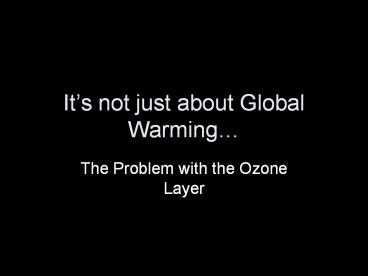It - PowerPoint PPT Presentation
1 / 17
Title:
It
Description:
It s not just about Global Warming The Problem with the Ozone Layer What is it? – PowerPoint PPT presentation
Number of Views:47
Avg rating:3.0/5.0
Title: It
1
Its not just about Global Warming
- The Problem with the Ozone Layer
2
What is it?
- "The ozone layer" refers to the ozone within
stratosphere, where over 90 of the earth's ozone
resides. - Ozone is an irritating, corrosive, colorless gas
with a smell something like burning electrical
wiring. - Each molecule of ozone has three oxygen atoms
(O3) and is produced when oxygen molecules (O2)
are broken up by energetic electrons or high
energy radiation.
3
What does it do?
- The ozone layer absorbs 97-99 of the sun's high
frequency ultraviolet light, light which is
potentially damaging to life on earth. - Every 1 decrease in the earths ozone shield is
projected to increase the amount of UV light
exposure to the lower atmosphere by 2.
4
What caused the hole?
- Human activities in the last several decades have
produced chemicals, such as chlorofluorocarbons
(CFCs), which have been released into the
atmosphere and have contributed to the depletion
of this important protective layer.
5
Links to Climate
- Ozone is also a greenhouse gas in the upper
atmosphere and, therefore, plays a role in
Earth's climate. - Under normal conditions, the amount of
stratospheric ozone depends on the amount of
sunlight reaching a certain geographic area of
the atmosphere. - Ozone typically "builds up" to higher values over
the poles during the winter and early spring in
each hemisphere. Because this season is offset by
6 months in the Northern and Southern
hemispheres, the effect is seen at the North and
South poles roughly 6 months apart.
6
How fast is it expanding?
- the "ozone hole" is where lower than normal
levels of ozone have been detected. - it is formed and destroyed by chemical reactions
that require light. - So the ozone hole is more intense when there is
sunlight over the south pole then where then is
darkness. - Human activities have made the hole much more
intense, but as far as we know there was always a
lower amount of ozone over the south pole (and to
a lesser extent over the north pole too) before
human activities altered the composition of the
atmosphere. - the ozone layer has also thinned in the temperate
and tropical zones on Earth
7
An Anthropogenic Issue!
- The data showed conclusively that human-produced
trace gases that contain chlorine and bromine
were causing the ozone hole. - The Global Monitoring Division of ESRL has
monitored the yearly Antarctic ozone hole from
the South Pole station and measuring total column
ozone from a ground based Dobson
spectrophotometer since 1963, and since 1986 by
launching balloons.
8
(No Transcript)
9
(No Transcript)
10
Driven by Temperatures
The ozone hole closes up in winter but
intensifies in the summer
- View of the Antarctic Ozone hole
- (July thru December)
11
Arctic Ozone Hole
- http//earthobservatory.nasa.gov/Newsroom/NasaNews
/ReleaseImages/20031210/07a_ozone2000.mpeg - Not as pronounced as the Antarctic Ozone Hole,
although does show up. (Blue regions indicate low
ozone levels)
12
Arctic Ozone Problem?
- Significant depletion also occurs in the Arctic
ozone layer during the late winter and spring
period (January - April). However, the maximum
depletion is generally less severe than that
observed in the Antarctic, with no large and
recurrent ozone hole taking place in the Arctic.
13
Why is a hole in the atmosphere an issue?
- If there is a hole in the ozone layer then this
means that more harmful ultra-violet rays get
through than are good for us or many other life
forms, plant or animal.
14
Too much ultra-violet light can result in
- Eye damage such as cataracts
- Immune system damage
- Reduction in phytoplankton in the oceans that
forms the basis of all marine food chains
including those in Antarctica. - Damage to the DNA in various life-forms So far
this has been as observed in Antarctic ice-fish
that lack pigments to shield them from the
ultra-violet light (they've never needed them
before) - Skin cancer
15
ozone-depleting gases
- These gases contain chlorine and bromine atoms,
which are known to be harmful to the ozone layer - CFCs hydrochlorofluorocarbons (HCFCs),
- human-produced gases once used in almost all
refrigeration and air conditioning systems - Methyl bromide,
- Primarily used as an agricultural fumigant
- Nitrous Oxides,
- oxidation of ammonia (NH3) primarily from
farming - Also a result of burning fossil fuels
16
Global warming and the ozone hole is there a
connection?
- The ozone hole is a completely different
phenomenon to global warming, however there are
links between them. The ozone hole is caused by
ozone depleting chemicals in the atmosphere,
which have been produced by industry, for example
CFCs.
17
Global warming and the ozone hole is there a
connection?
- One link is that CFCs are also 'greenhouse
gasses'. Enhanced global warming is a probable
consequence of increasing amounts of 'greenhouse
gasses', such as carbon dioxide and methane, in
the atmosphere. - Although the surface of the earth warms, higher
up the atmosphere cools, thus increasing the area
where stratospheric clouds can form. This makes
a larger area susceptible to ozone depletion and
provides another link between the two issues.































